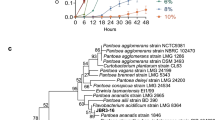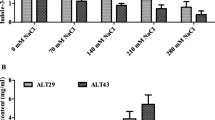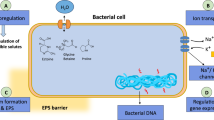Abstract
The effect of the Rs-5 bacteria strain, identified as Klebsiella oxytoca and isolated with ACC as the sole nitrogen source, on salt stressed cotton seedling growth was studied. It was demonstrated that Rs-5 could obviously relieve salt stress and promote cotton seedling growth. After treatment with Rs-5, the individual plant height and dry weight of cotton increased by 14.9 and 26.9%, respectively, compared to the control. Further analysis found that Rs-5 exhibited the ability to increase the cotton’s absorption of the N, P, K, and Ca elements and decrease the absorbability of the Na element under salt stress. In addition, Rs-5 itself could produce phytohormone-auxin, and was capable of dissolving phosphorus (P). The ratio of the dissolved P diameter to the colony diameter was 1.86. The dissolved P was 81.6 mg·l−1 in media after four days of incubation.




Similar content being viewed by others
References
Bacilio M, Rodriguez H, Moreno M, Hernandez JP (2004) Mitigation of salt stress in wheat seedling by a gfp-tagged Azospirillum lipoferum. Biol Fertil Soils 40:188–193
Caitriona D, Wilson LW, McFadden H (2004) Gene expression profile changes in cotton root and hypocotyl tissues in response to infection with Fusarium oxysporum f. sp. Vasinfectum. Mol Plant Microb Interact 17:654–667
Chabot R, Antoun H (1996) Growth promotion of maize and lettuce by phosphate-solubilizing Rhizobium leguminosrum biovar phaseoli. Plant Soi1 184:311–321
Cramer GR, Lauchli A, Polito VS (1985) Displacement of Ca2+ by Na+ from the plasmalemma of root cells. Plant Physiol 79:207–211
Cuartero J, Fernandez-Munoz R (1999) Tomato and salinity. Sci Hortic 78:83–125
Dworkin M, Foster J (1958) Experiments with some microorganisms which utilize ethane and hydrogen. J Bacteriol 75:592–601
Feng YH, Yao T, Long RJ (2003) Research progress of phosphate-dissolving microorganisms in plant rhizosphere. Grassland and Turf 1:3–7
Glick BR (2006) Modifying a plant’s response to stress by decreasing ethylene production. In: Phytoremediation rhizoremediation. Springer, Netherlands, pp 227–236
Glick BR, Penrose DM, Li JA (1998) Model for the lowering of plant ethylene concentrations by plant growth-promoting bacteria. J Theor Biol 190:63–68
Gordon SA, Weber RP (1951) Colorimetric estimation of indoleacetic acid. Plant Physiol 26:192–195
Greenway H, Munns R (1980) Mechanisms of salt tolerance in nonhalophytes. Annu Rev Plant Physiol 31:149–190
Leshem YY, Halevy AH, Frenkel C (1990) Senescence and dormant of plant. Publishing House of Liaoning, Shenyang, pp 46–47
Li LQ, Wang X (2003) Utilization of water resources and analysis of agricultural sustainable development in Xinjiang. China Water Resources 54–57
Li FH, Benhur M, Keren R (2003) Effect of marginal water irrigation on soil salinity, sodicity and crop yield. Transactions of Chinese Society of Agricultural Engineering 19:63–66
Ma FY, Zhou ZG, Zheng Z (2004) The development and improvement of drip irrigation under plastic film on cotton. Agricultural Research in the Arid Areas 22:202–208
Markus W, Helmut J, Wilfried HS (2004) Bacillus subtilis as growth promotor in hydroponically grown tomatoes under saline conditions. Acta Hortic 1(659):363–369
Martinez V, Lauchli A (1994) Salt-induced inhibition of phosphate uptake in plants of cotton (Gossypi um hirsutum L.). New Phytol 125:609–614
Mayak S, Tirosh T, Glick BR (2004) Plant growth-promoting bacteria confer resistance in tomato plants to salt stress. Plant Physiol Biochem 42:565–572
Mo WP, Zheng YY, Yue HT, Li H (2006a) Preliminary study on action mechanism and isolation of strains for relieving-salt-stress and promoting growth of cotton. Journal of Shihezi University 24:32–36
Mo WP, Li CH, Zheng YY, Yue HT, Li H (2006b) Effect of relieving-salt-stress and growth-promoting bacteria on germination of cotton seeds under salt stress. Transactions of Chinese Society of Agricultural Engineering 22:260–263
Patten CL, Glick BR (2002) Role of Pseudomonas putida indoleacetic acid in development of the host plant root system. Appl Environ Microbiol 68:3795–3801
Qadir M, Ghafoor A, Murtaza G (2000) Amelioration strategies for saline soils: a review. Land Degrad Dev 11:501–521
Ribaut JM, Pilet PE (1994) Water stress and indol-3yl-acetic acid content of maize roots. Planta 193:502–507
Riehm H (1985) Arbeitsvorschrift zur Bestimmung der Phosphorsaure und des Kaliums nach der Laktatmethode. Zeitschrift fur Pflanzen Dungung und Bodenkunde 40:152–156
Schachtschnabel P, Heinemann CG (1974) Beziehungen zwischen den Kaliumgehalten in Boden und in jungen Haferpflanzen. Zeitschrift fur Pflanzen Dungung und Bodenkunde 137:123–134
Shah S, Li J, Moffatt BA, Glick BR (1998) Isolation and characterization of ACC deaminase genes from two different plant growth-promoting rhizobacteria. Can J Microbiol Microbiol 44:833–843
Syed MA (1999) Nutrient uptake by plants under stress conditions. In: Pessarakli M (ed) Handbook of plant and crop stress. Marcel Dekker, New York, pp 295–296
Tao J, Zhao S, Li H (2006) Study on effect of growth promotion and control diseases to processing tomato of Bacillus sp. SL-23 and SL-44. Xinjiang Agricultural Science 43:362–365
Xu FP, Li YK, Ren SM (2003) Investigation and discussion of drip irrigation under mulch in Xinjiang Uygur Autonomous Region. Transactions of Chinese Society of Agricultural Engineering 19:25–27
Yao T (2004) Associative nitrogen-fixing bacteria in the rhizosphere of Avena sativa in an alpine region III phosphate-solubilizing power and auxin production. Acta Prataculturae Sinica 13:85–90
Zhao XR, Lin QM, Li BG (2003) The relationship between rock phosphate solubilization and pH and organic acid production of microorganisms. J Microbiol 23:5–7
Acknowledgements
This work was supported by the Key Lab Foundation of the Xinjiang Academy of Agricultural Science (XJYS0203-2005-03) and Natural Science Foundation of Shihezi University (ZRKX2005024). We also acknowledge members of our laboratory for assistance in the soil sampling. Haitao Yue and Wenping Mo contributed equally to this work, and are co-first author.
Author information
Authors and Affiliations
Corresponding author
Additional information
Responsible Editor: Petra Marschner.
Rights and permissions
About this article
Cite this article
Yue, H., Mo, W., Li, C. et al. The salt stress relief and growth promotion effect of Rs-5 on cotton. Plant Soil 297, 139–145 (2007). https://doi.org/10.1007/s11104-007-9327-0
Received:
Accepted:
Published:
Issue Date:
DOI: https://doi.org/10.1007/s11104-007-9327-0




